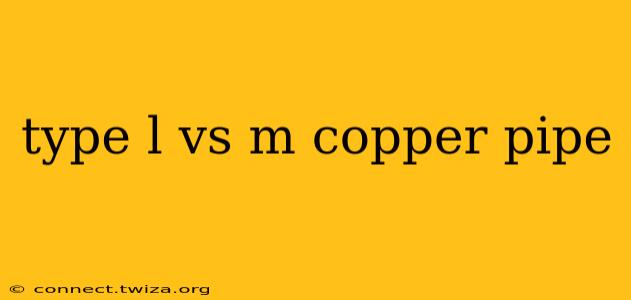Choosing the right copper pipe for your plumbing project is crucial for ensuring long-term durability and performance. Two common types, Type L and Type M, are frequently used, but understanding their differences is key to selecting the appropriate one. This comprehensive guide explores the key distinctions between Type L and Type M copper pipes, helping you make an informed decision.
What are Type L and Type M Copper Pipes?
Both Type L and Type M copper pipes are made from annealed (soft) copper, offering excellent corrosion resistance and water purity. The difference lies in their wall thickness: Type L has a thicker wall than Type M. This seemingly minor difference significantly impacts their applications and suitability for various pressures.
Type L Copper Pipe: Thick Walls for High Pressure
Type L copper pipe boasts the thickest walls of the common copper pipe types. This robust construction makes it ideal for high-pressure applications, such as:
- Main water lines: Where water pressure is consistently high, Type L's thicker walls provide superior strength and prevent bursting or leaks.
- Underground plumbing: Buried pipes are subject to significant external pressure and potential damage. Type L's durability offers greater protection against these stresses.
- High-rise buildings: The increased water pressure in taller buildings necessitates the use of a heavy-duty pipe like Type L.
Type M Copper Pipe: A Balanced Approach for Moderate Pressure
Type M copper pipe offers a balance between wall thickness and cost-effectiveness. While not as robust as Type L, its walls are still thicker than Type DWV (drain, waste, and vent) copper pipes, making it suitable for many residential and commercial applications where the pressure is moderate, including:
- Branch lines: Distributing water from the main line to individual fixtures usually requires less robust piping than the main line itself.
- Interior plumbing: Within a home or building, the pressure is typically lower than in the main water line, making Type M a suitable and cost-effective choice.
What is the Difference in Wall Thickness?
The primary distinction between Type L and Type M lies in their nominal wall thickness. While precise measurements vary slightly based on the pipe diameter, Type L generally has a significantly thicker wall than Type M. This results in Type L being more resistant to higher water pressures and external forces.
Which Type of Copper Pipe is Right for My Project?
The best choice depends entirely on your specific plumbing project's requirements:
- High-pressure applications or demanding environments (e.g., underground lines, main water lines): Choose Type L. Its superior strength and durability justify the higher cost.
- Moderate-pressure applications (e.g., branch lines, interior plumbing in most residential settings): Type M offers a good balance between strength and cost.
Always consult local plumbing codes and regulations to determine the appropriate pipe type for your specific situation. A licensed plumber can also provide expert guidance in selecting the right material for your needs.
Is Type L Copper Pipe More Expensive Than Type M?
Yes, Type L copper pipe is generally more expensive than Type M due to its thicker walls and the increased material used in its production. However, the added cost often translates to increased longevity and reliability, particularly in high-pressure applications where failure could be costly.
What are the Advantages and Disadvantages of Each Type?
Type L Advantages: High strength, durability, suitable for high-pressure applications, longer lifespan. Type L Disadvantages: More expensive than Type M.
Type M Advantages: Cost-effective, suitable for moderate-pressure applications, easier to work with (due to slightly thinner walls). Type M Disadvantages: Not suitable for very high-pressure applications or demanding environments.
Can I Use Type M Copper Pipe Where Type L is Specified?
No. Using a thinner-walled pipe (Type M) where a thicker-walled pipe (Type L) is specified by code or is required by the application could lead to leaks, bursts, and potential damage. Always adhere to building codes and professional recommendations for pipe selection.
This detailed comparison should help you understand the crucial differences between Type L and Type M copper pipes, enabling you to make the right selection for your next plumbing project. Remember, consulting with a qualified plumber is always recommended for complex installations or when unsure about the appropriate pipe type.
